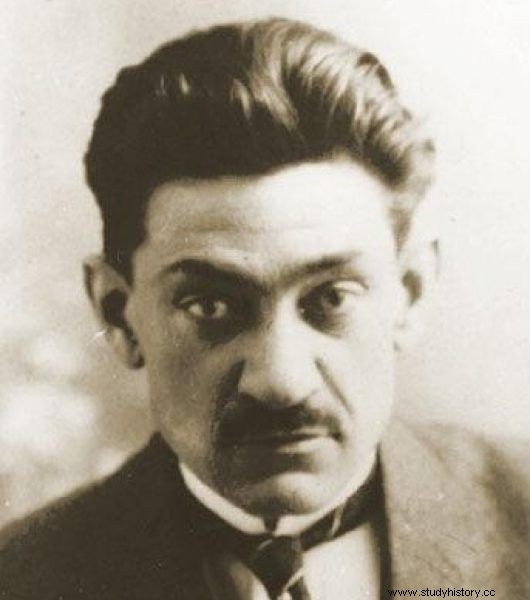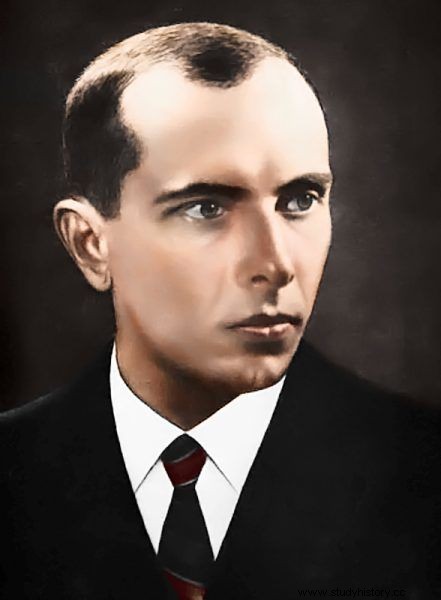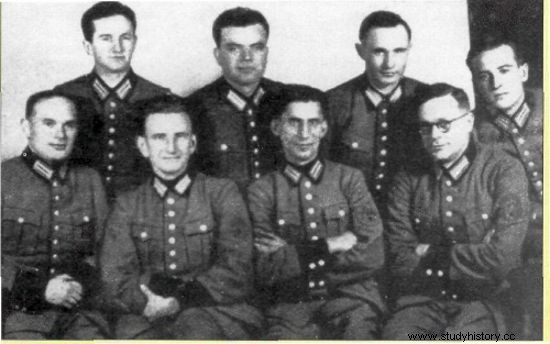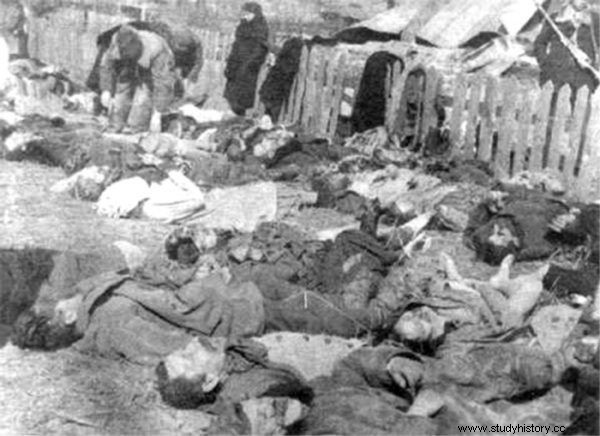It is easy to throw the responsibility on the war that blunts human reflexes, on the brutality of the enemy and the sins of nationalism. But is this the whole explanation for the enormity of the crime committed in 1943?
Various arguments are used in the discussion about the causes of the Volhynia massacre. On the Ukrainian side, attention is drawn to the difficult situation of the Ukrainian national minority in the Second Polish Republic. Indeed - Poland did not introduce autonomy in Eastern Galicia, to which it was obliged by the arrangements with the Entente countries . The Ukrainian minority of between 4.5 and 6 million people in the Second Polish Republic experienced various humiliations.
For example - the number of Ukrainian schools between 1924 and 1938 fell from 2,558 to 461 schools. The use by the Polish authorities of collective responsibility in response to the sabotage activity of Ukrainian nationalists (as during the pacification in 1930) or various actions to "strengthen Polishness" (the demolition of the church in the Chełm region in 1938) was certainly not conducive to the loyalty of the Ukrainian minority towards the state.
Social differences overlapped the national conflict. The Ukrainian population was generally worse off and less educated. Poles also had a tendency, as noted by the Czech pastor Jan Jelinek, whose words are quoted by Witold Szabłowski in his book Righteous Traitors. Neighbors from Volhynia, to pride and contempt for other nations. The pastor said:
After capturing Zaolzie, they started treating us [Czechs from Volhynia] exactly as they treated the Ukrainians before. Ukrainians often speak Polish poorly, but they were required to do so in their offices. If someone did not speak, the clerk pretended not to understand. They did so, despite the fact that there were very few Poles in Volhynia! I read in the newspaper that only 16 percent. And Ukrainians - almost 70.

Monument commemorating the demolition of the church of St. Anna in Międzylesie on July 14, 1938. Such actions meant that the Ukrainians living in the Second Polish Republic did not treat this country as their homeland, but as an occupant (author:Loraine, license:CC BY-SA 4.0).
Such an attitude, resulting from shoes and a sense of superiority, aroused hatred towards Poles in the despised. However, it should be remembered that although the situation of Ukrainians in Poland was difficult, it still remained better than in Romania (not to mention the Soviet Union). This tells us that the immediate causes of the Volhynia massacre should be sought elsewhere.
"Creative Violence"
Much data indicates that the causes of the genocide in Volhynia are closely related to the ideology of Ukrainian integral nationalism. The most important ideologist of this was Dmytro Doncow. This thinker published his magnum opus in Lviv in 1926 - "Nationalism".
In this work, Doncow reinforced the view of "creative violence", which is one of the necessary elements of nationalism . The ideologist also argued that liberal ethnic politics was characterized by "weak races", and that during the struggle for "self-affirmation", "no whims of national minorities" should not be noticed. Doncov's journalism did not have a clearly anti-Polish meaning. It is also in vain to look for specific plans of action against nations hostile from the point of view of Ukrainian nationalism. Doncow's work was rather an ideological manifesto that was translated into the language of political practice by others.
Older Conservatives and Angry Young
They were radical activists of the young generation active in the National Executive of the Organization of Ukrainian Nationalists. Established in February 1929 as a result of the merger of several smaller nationalist organizations, the OUN set itself the goal of conquering the Ukrainian state along the route of the national revolution.
On the basis of real politics, the organization focused mainly against Poland, often resorting to terrorist and sabotage activities. Ideologically, the OUN was a diverse organization. The activists of the older generation focused on emigration, remembering the previous independence uprising, were characterized by less radicalism than the youth growing up in Eastern Galicia.
The first of these groups was not uniform. Apart from radicals, there were also figures with views close to conservatism, such as Dmytro Andrijewski or Yevhen Onacki. These activists openly opposed the terror , cruelty towards enemies and called for the cooperation of the OUN with legal Ukrainian parties.

Dmytro Doncow became the main ideologist of Ukrainian nationalists. In his magnum opus "Nationalism" he formulated the view of "creative violence" (public domain).
Young radicals forming in Eastern Galicia under the influence of Doncov's ideas thought in completely different categories. Their intellectual structure is perfectly illustrated by Stepan Bandera's words uttered during the Lviv trial in 1936. The future leader of the OUN-B said:
The CNS values human life and values it very much, but our idea is so great that when it comes to its implementation, it is not individuals, not hundreds, and millions of sacrifices must be sacrificed to make it happen.
The idea behind the radical wing of the OUN was to establish a nationalist empire that stretched from Nowy Sącz to the Caspian Sea and had extensive influence in Asia.
How to solve the "Polish question"?
OUN activists saw the possibility of realizing their ideal in the collapse of the Versailles order as a result of the pan-European armed conflict . The revisionist actions of fascist Italy and Nazi Germany made the prospect of a European war in the second half of the 1930s real.

For Stepan Bandera, the lives of millions of victims were nothing compared to the great idea he preached (author:Alexey Marenko, license:CC BY-SA 3.0).
This situation gave new impetus to the creation of the political concept of Ukrainian nationalism. This time, an important issue was the attitude towards national minorities in the future Ukrainian state. In 1939 in Paris, a work by the most radical OUN activist of the older generation, Mykola Sciborski, was published, entitled "The Agrarian Question".
Apart from the issues related to the division of land, Sciborski discussed the methods that should be used to undo the consequences of the colonization of Ukrainian lands by the "hostile element". According to the activist most of the Polish-Muscovites and other strangers it was supposed to be liquidated during the Ukrainian national revolution . Any survivors should be forcibly deported.
Next to Bandera and Shutchevych
At the same time, the minority issue was discussed during the preparations for the Second Congress of Ukrainian Nationalists (held in Rome in August 1939). The person responsible for this task was Jarosław Stećko. This character requires a bit more attention due to his later fate.

Mykoła Sciborski believed that the "foreign element" in the future of Ukraine must be "liquidated". In the photo, first from the right, accompanied by H. Łysiuk, J. Konovalec and I. Rudakiv in Paris, 1929 (public domain).
In June 1941, Stećko became the prime minister of the "renewed Ukrainian State", established on the initiative of the OUN-B. Later, in exile, he was the chairman of the OUN Foreign Formations for many years. Without a shadow of exaggeration, he can therefore be considered the most important OUN-B activist, next to Stepan Bandera and Roman Shukhevych.
On the eve of the outbreak of World War II, Stećko wrote that the minority issue in Ukraine should cease to exist . He saw three paths to this goal:assimilation, deportation, and "physical means." The views of another radical activist of the younger generation, Mychajła Kołodziński, tell us a lot about what could have been hidden under the last of the methods proposed by Stećka.
In the Military Doctrine of Ukrainian Nationalists, established in 1938, he predicted that during the national uprising caused by the OUN, there would be an opportunity to "purge Ukraine of a foreign hostile element." According to Kołodziński, the Poles who resisted were to die in the fight, and the rest:to be terrorized and driven out over the Vistula.
From Dmytrowa to Volyn
In fact, what OUN activists called for has already happened. So far, almost imperceptibly. According to the memoirs of the national OUN activist Bohdan Kazaniwski, in 1937 a unit of Ukrainian nationalists forced them to abandon the property of Polish colonists living near the village of Dmytrowa. Poles left under the threat of death.
When the Polish-German war began, the OUN's actions gained momentum. According to the data cited by Grzegorz Motka, 796 Poles died in the OUN subversive actions from August 29 to September 23, 1939.
According to the memoirs of the aforementioned Czech pastor from the village of Kupiczów, quoted by Witold Szabłowski in the book "Righteous Traitors. Neighbors from Volhynia ”: Ukrainians have been repeating from the beginning of the war that Ukraine will be cleansed of all other nations. That it will be like a tear .
The destruction of Polish statehood has not yet created the conditions in which the vision of Ukrainian radicals could be implemented. Although the massive Soviet deportations to Siberia deepened the disrespect for human life, the totalitarian nature of the USSR left no room for the activities of the OUN-B.

Roman Szuchewycz (seated second from left) accompanied by other members of the Nachtigall battalion (source:"Ukrainska Pravda", public domain).
When human life loses its value
The invasion of the Germans changed the situation by 180 degrees. The annihilation of the Jewish population completely defrauded the value of human life. Any strong state structures in the former borderlands of the Second Polish Republic ceased to exist. American historian Timothy Snyder rightly points out that this factor contributed to the Holocaust taking on a larger scale there than in any other part of occupied Europe .
The conditions created by the Germans were conducive to the realization of radical visions of Ukrainian nationalists. The death machine launched by the Nazis also allowed its participants to undergo a kind of "combat baptism" . Its participants were also Ukrainians serving in the auxiliary police. In March and April 1943, they deserted from the service and then joined the UPA. At that time, the Bandera followers were already carrying out the first "anti-Polish actions".

Murdered Poles in Lipniki (public domain).
Witold Szabłowski is undoubtedly right when describing the fate of those who saved their neighbors in Volhynia, he writes: Nation and religion do not murder. Man can murder and it is the man who should be blamed . Man should be blamed as the creator of an ideology that perceived the imaginary "our cause" as more important than human life.
This ideology was certainly not the Ukrainian national idea. Moreover, even some OUN activists opposed it. But this ideology was certainly a destructive branch of Ukrainian nationalism, which should be associated with, among others, the names of Doncow, Sciborski, Stećka, Kołodziński and Bandera.
Selected bibliography
- Jarosław Hrycak, Strasti for nationalism. Old istorija for a new order , Kyiv 2011.
- Anatoly Kentij, Armed act of Ukrainian nationalists 1920-1956. Istoryko-archival scratches , vol. 1, Kyiv 2005.
- Grzegorz Motyka, Ukrainian partisans 1942-1960 , Warsaw 2006.
- Myrosław Shkandrij, Ukrainian nationalism. Politics, Ideology, and Literature , 1929-1956, New Haven-London 2015.
- Timothy Snyder, Black Earth. Holocaust as a warning , Krakow 2015.
- Timothy Snyder, Bloodlands. Europe between Hitler and Stalin , Warsaw 2011.
- Witold Szabłowski, Righteous Traitors. Neighbors from Volhynia , Krakow 2016.
- Roman Wysocki, Organization of Ukrainian Nationalists in Poland in 1929-1939 , Lublin 2003.
- Roman Wysocki, In the circle of integral nationalism. "Active nationalism" by Dmitry Doncov against the background of Roman Dmowski's "modern thoughts". A comparative study , Lublin 2014.
- Oleksandr Zaitsev, Ukrajinśkyj integral nationalism (1920-1930-thi roky). Drawings intełektualnoji istoriji , Kyiv 2013.
- Andrzej Zięba, Lobbying for Ukraine in Interwar Europe. Ukrainian Press Office in London and its political competitors (until 1932) , Krakow 2010.
